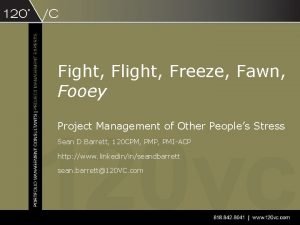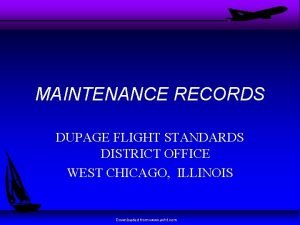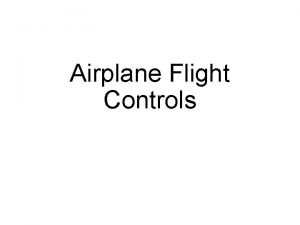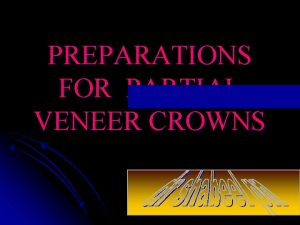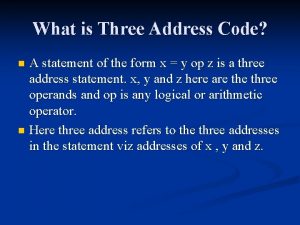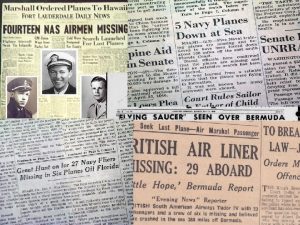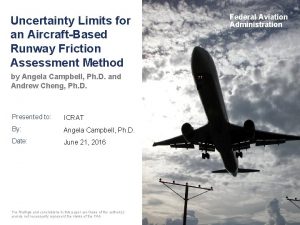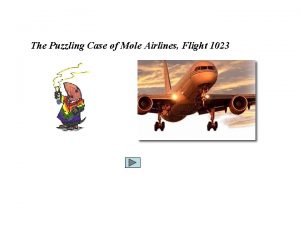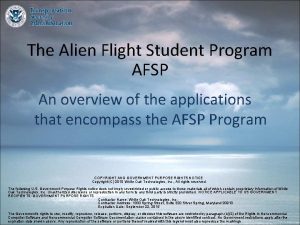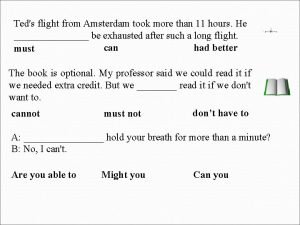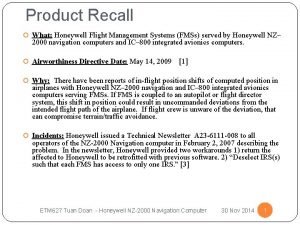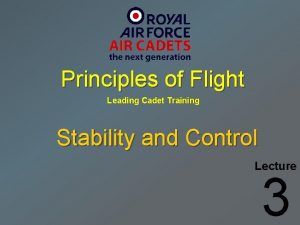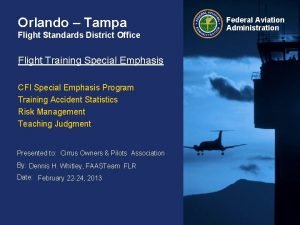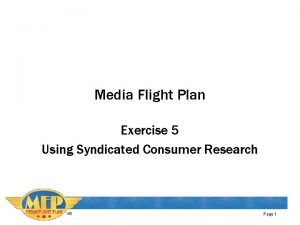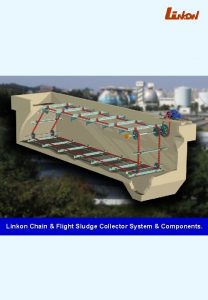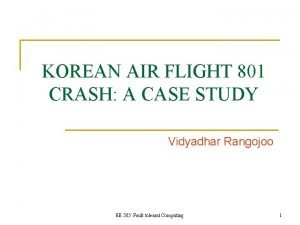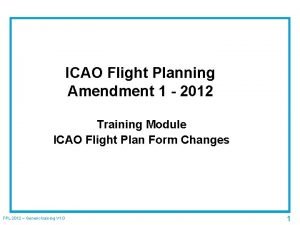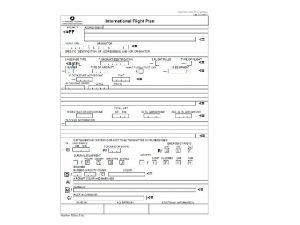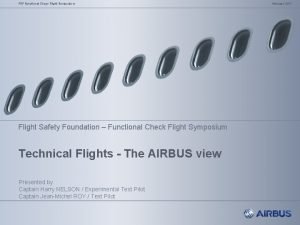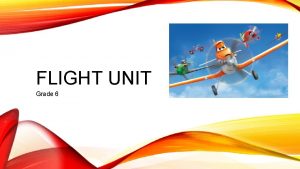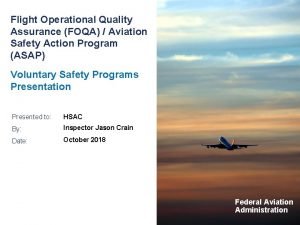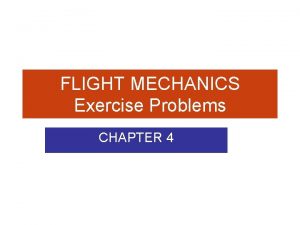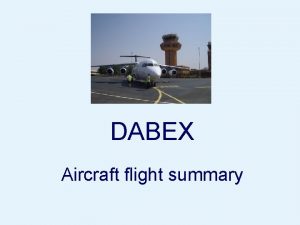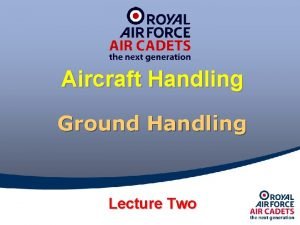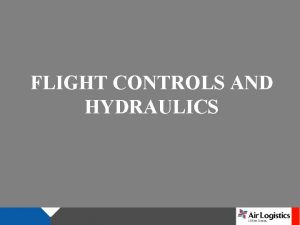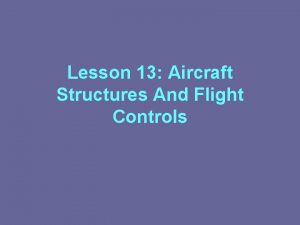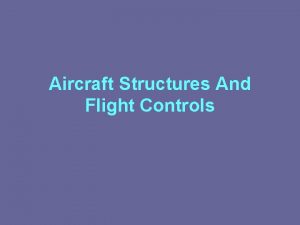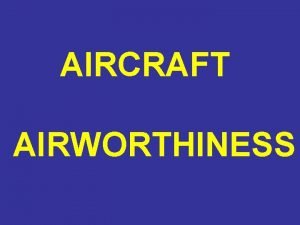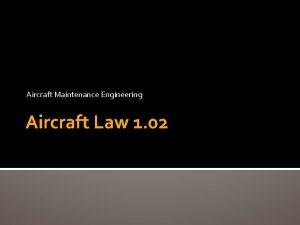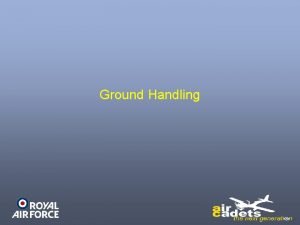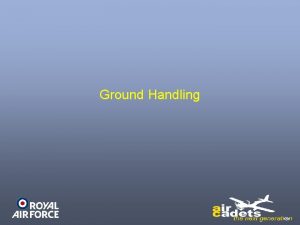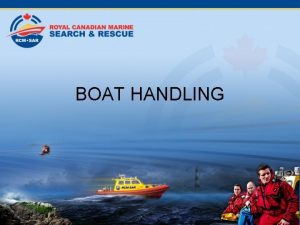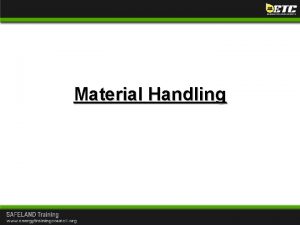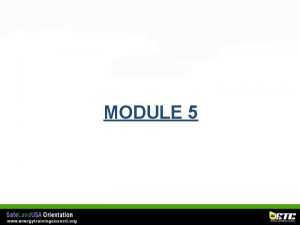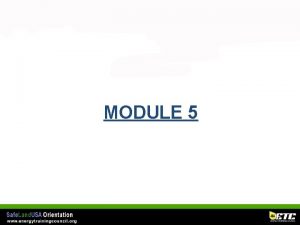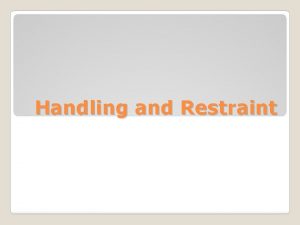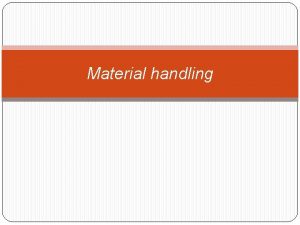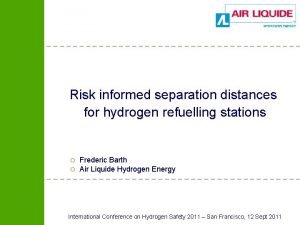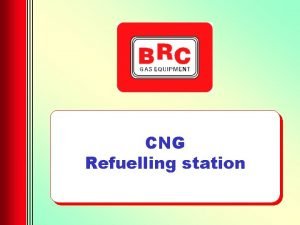Aircraft Handling Flight Preparation Lecture Three Refuelling Aircraft










































- Slides: 42

Aircraft Handling Flight Preparation Lecture Three

Refuelling Aircraft are usually refuelled after every flight, to prevent condensation in the empty tank. This also reduces the setup time for future sorties. Aircraft may be refuelled in many ways: Jerry cans Bowsers (the most common at military airfields) High pressure from ground tanks Hand or mechanical pump from ground or portable tanks Air to Air Refuelling (AAR)

Refuelling Pressure Refuelling (where fuel is pumped into the aircraft at high pressure) dramatically reduces refuelling time. Aircraft are fitted with shut off valves which automatically close when the fuel in the tanks reaches the required level.

Refuelling Fire is a real risk during any refuelling. Bonding (linking metal parts with a conductor) prevents sparks from static electricity during refuelling. Work on electrical or radio equipment is prohibited within 15 metres of an aircraft being refuelled.

Refuelling Precautions whilst refuelling - Adequate fire cover required. - Aircraft bonded and earthed to reduce static sparks. - Refuelling crews wear rubber-soled shoes if possible. - No naked lights. - No R/T transmissions. - Refuelling vehicles positioned so they can be quickly moved in the event of a fire.

Refuelling Aviation Fuels used in the RAF and RN fall into one of 4 categories: AVGAS - Aviation Gasoline (piston engine aircraft) AVTUR - Aviation Turbine (gas-turbine engines) AVTAG - Emergency military use only - Freezing point lower than AVTUR AVCAT - Largely used by Royal Navy - Higher flashpoint than AVTUR

Refuelling G G are types of Gasoline. AVGAS & AVTAG If the name has a ‘G’ in it, it’s a type of Gasoline used on piston engines. T AVTUR & AVTAG Most gas turbine engines T can be run on AVTUR or AVTAG. The middle ‘T’ stands for Turbine as used in jet engines. and R is made from Kerosene. AVTUR There’s an R in AVTUR, and an R in Ke. Rosene.

Loading Aircraft loads must be securely stowed and correctly distributed to ensure that the centre of gravity (C of G) is within the limits. Large aircraft have an Air Load Master / Air Quartermaster, who supervise the loading process.

Loading Overloading has the following effects: Increases take off & landing distances. Increases the stalling speed. Reduces rate of climb. Reduces range. Reduces endurance. Reduces the aircraft’s ceiling height. In a twin or multi-engined aircraft it may make it impossible to maintain flight in the event of an engine failure.

Loading It is of little use ensuring that the maximum all up weight is not exceeded if the aircraft is not properly balanced owing to the uneven distribution of the load. The load must be distributed so that the C of G falls within the limits for the aircraft. The aircraft is then correctly balanced fore and aft and may be flown safely.

The Captain On any aircraft, there must be one person in charge who, however well his crew are doing their jobs, is the one to take charge in an emergency. That person is the Aircraft Captain. Any member of an aircraft crew may be appointed as the captain, but this appointment is most often held by the pilot.

The Captain The most important quality of the Captain is LEADERSHIP. The Captain must ensure flight preparation for themselves and their crew, including: Familiarity with the aircraft, their roles, their training and their confidence. The aim of the flight. The personal fitness of themselves & crew members. The relevant order books have been read & understood: Military Flying Regulations, Air Staff Instructions and the Station Flying Order Books.

The Captain The most important quality of the Captain is LEADERSHIP. The Captain must ensure flight preparation for themselves and their crew, including: Serviceability checks have been made on personal safety equipment items by each individual user. That all serviceability checks have been completed. Flight planning & navigation checks are complete. Where passengers are carried, they are fully briefed. On a transport aircraft, the Captain will normally delegate this responsibility to the Air Loadmaster.

Flight Preparation Flight Planning requires knowledge of: The weather conditions at the time and a forecast of how the weather is likely to change during the flight. ATC clearance. Details of available diversion airfields and restricted airspace’s in the region of the flight. Navigation pre-calculations and preparation of maps and charts.

Flight Preparation BRIEFINGS “Self briefings” enable the Pilot/Nav to use Met and ATC information displayed in the Ops/flight planning room to complete the flight plan and prepare maps and charts. Many units hold a “mass briefing” for all aircrew at the start of the day’s flying; the Sqn OC, ATC, Wx and other departments brief crews on their areas.

Flight Preparation BRIEFINGS Passenger briefings vary but typically include: That the captain of the aircraft is in command, irrespective of rank, whilst in flight. Use of safety straps, crash & ditching positions. Escape hatches & dinghy positions. Fitting oxygen masks & operating the oxygen flow controls. Fitting and operate parachutes. Smoking & naked flame rules when applicable. Operating R/T communication equipment.

Flight Preparation Authorisation Formal authorisation is required before every flight. This is normally done by the Flight or Squadron Commander in the Flight Authorisation Book (Form 3562). In the event of an accident or breach of flying discipline, the relevant form 3562 will be impounded by the investigating authority.

Flight Preparation Authorisation The Captain also signs the Form 705, to certify that: Flight servicing has been carried out. The aircraft is shown as serviceable. Time before the next scheduled servicing is sufficient. The quantities of fuel, oil, oxygen and armament are sufficient for the flight. They are aware of work done on the aircraft since its last flight. It has been signed by the Flight Services Co-ordinator.

Pre-Flight Checks On approaching the aircraft the pilot will note: Position in relation to other aircraft. Position in relation to obstructions. Routes to the taxiway. FOD. Whether clear to start engines. Condition of ground. Aircraft is properly chocked. Aids to starting engines properly positioned. Starting crew & fire extinguishers in place.

Pre-Flight Checks Detailed checks for the type of aircraft will be found in the Aircrew Manual for the type of aircraft, but will normally include: External checks. Cockpit checks before starting engines. Warming up and running up (piston engines). Pre-take off checks.

Pre-Flight Checks may often be in “card” form and are “called off” to the pilot by another crew member by challenge and response. Checks are a pre-requisite of every flight. They are integral to the team work that goes into preparing the aircraft and crew for flight. They are the final steps in ensuring that all is ready for take off.

Pre-Flight Checks The pilot will usually check – Inside the cockpit to ensure the brakes are on and switches are off. The fuselage, wings & tail plane surfaces for signs of damage, ice, fuel or oil leaks etc. , and check fastenings of inspection panels. The pitot head & static vent covers, engine covers & blanking plates are removed. The external control & undercarriage locks. The undercarriage for serviceability, noting signs of damage or excessive wear in tyres and wheels.

Pre-Flight Checks Before starting engines, the Captain must check that his starting crew are in place with fire extinguishers at hand, and the crew and passengers are correctly seated and strapped in. He will then check the cockpit to ensure that fuel and other services required are switched on. The undercarriage is selected down and is shown as being locked down. The brakes are locked on and pressurised and the engines are switched as required.

Starting Engines Starting engines is a team procedure between the pilot and the ground handling team. The pilot indicates the engines are ready to be started by shouting “All clear for starting? ”. The Ground crew will then check it is clear. The pilot then repeats this before starting the engine.

Check of Understanding One of the reasons we refuel aircraft after every flight is to prevent what? Build-up of static electricity Condensation in the refuelling hose Condensation in the fuel bowser Condensation in the fuel tank

Check of Understanding What is the most common delivery method for refuelling at a military airfield? Portable Tanks Jerry Cans Hydrants Bowsers

Check of Understanding What type of aircraft refuelling can dramatically reduce refuelling time? Pressure Refuelling Open-line refuelling Mobile Bowser Refuelling Team Refuelling

Check of Understanding During refuelling, aircraft bonding is achieved to eliminate the fire risk caused by what? Over-pressurisation Condensation Static electricity Fuel leaks

Check of Understanding Which aviation turbine fuel is made from kerosene? AVTAG AVTUR AVGAS AVCAT

Check of Understanding The majority of gas turbine engines run on one of which two fuels? AVGAS or AVTUR or AVTAG or AVGAS AVCAT or AVTUR

Check of Understanding AVGAS and AVTAG are both types of what? Turbine Fuel Kerosene Diesel Gasoline

Check of Understanding Increased stalling speed, landing and take-off run, and reduced climb performance, can all be the results of what? Poor planning Excess fuel Overloading Wind speeds

Check of Understanding The aircraft load must be correctly distributed to ensure that: The centre of gravity is within limits. Freight can be offloaded in the correct order. No damage is done to the load in flight. Access to aircraft doors is not impaired.

Check of Understanding Whose duty is it to ensure that a crew is properly prepared for a flight? The station commander The crew chief The air loadmaster The aircraft captain

Check of Understanding Who is responsible for serviceability checks on personal safety equipment items? The crew chief The captain The individual The flight safety officer

Check of Understanding Who is responsible for ensuring that any passengers are briefed before a flight? The crew chief The air loadmaster The captain The movements officer

Check of Understanding When pilots or navigators use information displayed in the flight planning room to do their flight planning it is known as: Team briefing Self briefing Mass briefing Solo briefing

Check of Understanding Following an aircraft accident or breach of flying discipline, Which RAF Form is impounded by the investigating authority? F 700 F 3562 F 705 F 3822

Check of Understanding During pre-flight checks a captain will ensure that the starter crew are in place with which of the following close at hand? Spare fuel Ear defenders Fire extinguishers Safety equipment

Check of Understanding Which of the following forms does an aircraft captain sign before flight and after flight? F 700 F 705 F 3562 F 3822

Check of Understanding Where would you find detailed checklists for a particular aircraft type? The aircraft manual The aircrew manual The flight manual In the F 700

Aircraft Handling End of Presentation
 Iraad definition project management
Iraad definition project management Dupage flight center aircraft maintenance
Dupage flight center aircraft maintenance 01:640:244 lecture notes - lecture 15: plat, idah, farad
01:640:244 lecture notes - lecture 15: plat, idah, farad What are the 3 primary flight controls
What are the 3 primary flight controls Three strategies for handling anger in a healthful way
Three strategies for handling anger in a healthful way Three quarter crowns
Three quarter crowns 3 hobbits
3 hobbits Othello act 3 summary
Othello act 3 summary In three minutes write three things you did yesterday
In three minutes write three things you did yesterday Orange diamond shaped signs warn the motorist of
Orange diamond shaped signs warn the motorist of The three colonial sections-one society or three
The three colonial sections-one society or three Three address statement
Three address statement Bermuda map
Bermuda map Wg enloe high school
Wg enloe high school Southwest airlines flight 1248
Southwest airlines flight 1248 Weedhopper ultralight
Weedhopper ultralight The puzzling case of mole airlines flight 1023
The puzzling case of mole airlines flight 1023 Alien flight student
Alien flight student Ted's flight from amsterdam took more than
Ted's flight from amsterdam took more than Top flight parachutes
Top flight parachutes Time of flight formula
Time of flight formula Projectile motion equations
Projectile motion equations Honeywell flight management system
Honeywell flight management system Principles of flight air cadets
Principles of flight air cadets Parachute designs for ping pong balls
Parachute designs for ping pong balls Our lady of flight
Our lady of flight Flight training tampa
Flight training tampa Media flight plan
Media flight plan Flight sludge collector
Flight sludge collector Boeing flying club
Boeing flying club Flight 801
Flight 801 Composite flight plan
Composite flight plan Flight plan 2012
Flight plan 2012 Function of pituitary gland in points
Function of pituitary gland in points Honor flight oregon
Honor flight oregon Southwest flight 417
Southwest flight 417 Ats flight plan
Ats flight plan Maximum number of stairs in a flight
Maximum number of stairs in a flight Flight safety foundation
Flight safety foundation Flight school management software
Flight school management software Grade 6 flight unit
Grade 6 flight unit Ac 120-66c
Ac 120-66c The altimeter on a low-speed airplane reads 2km
The altimeter on a low-speed airplane reads 2km
